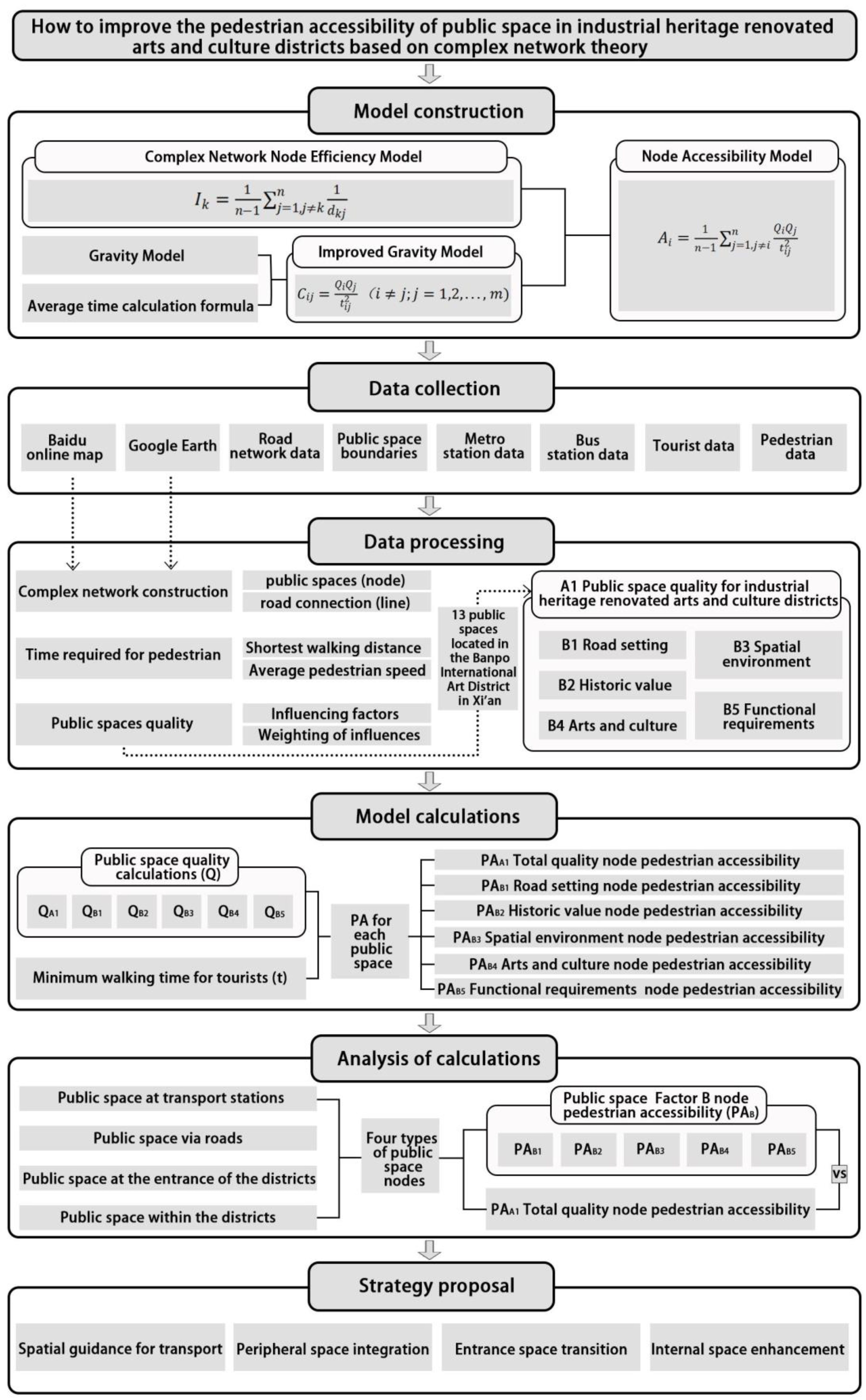Modeling Pedestrian Accessibility: Research on Public Space of Industrial Heritage Renovated Districts
Abstract
1. Introduction
2. Materials and Methods
2.1. Research Framework
- (1)
- Pedestrian accessibility model construction: This research applied complex network theory to examine pedestrian accessibility in industrial heritage renovated public spaces, integrating the node efficiency model with an improved gravity model to propose the node pedestrian accessibility model.
- (2)
- Data collection: By taking Banpo International Art District in Xi’an as a case study, on-site research was conducted by surveying 124 visitors who walked from nearby transport stations to the public spaces of the art district to define the scope of study area. Based on the definitions of public space provided in the literature, this study selected 13 public spaces within the scope as research subjects. The shortest distance between two spaces was obtained in Baidu Maps V21, with the starting and end points positioned at the center of mass for each public space. Moreover, the evaluation criteria for space quality were based on expert consulting, public opinions, extensive literature reviews [36,37,38,39,40,41], standards and specification [42,43,44], and practical case studies. To test the reliability of this evaluation system, a criticality questionnaire was developed, and 35 industry experts were invited to assess the importance of selected factors across 5 dimensions. The research employed an on-site questionnaire to gather visitors’ evaluations of each space, collecting a total of 124 valid responses.
- (3)
- Data processing: Based on the data obtained above, a public space network was constructed with public spaces as nodes and road connections as lines; the quality evaluation index system of public space and weighting of each impact factor were determined, and the total quality of each public space and the quality in each aspect were calculated; moreover, based on the shortest distance between the two spaces and the average pedestrian speed, the shortest travel time was calculated.
- (4)
- Pedestrian accessibility calculation: Pedestrian accessibility in each space was described by 6 indicators, namely, PAA1 (total quality node pedestrian accessibility), PAB1 (road setting node pedestrian accessibility), PAB2 (historic value node pedestrian accessibility), PAB3 (spatial environment node pedestrian accessibility), PAB4 (arts and culture node pedestrian accessibility), and PAB5 (functional requirement node pedestrian accessibility).
- (5)
- Pedestrian accessibility analysis: Based on the different functions of selected nodes, this study categorized the 13 public spaces in the network into four categories and the pedestrian accessibility of each indicator was analyzed separately.
- (6)
- Optimization strategy proposal: Based on the above analysis, corresponding optimization strategies were proposed to address the pedestrian accessibility challenges faced by different categories of public spaces.
2.2. Method
2.2.1. Node Accessibility of Public Space
2.2.2. Quality of Public Space
- (1)
- Quality evaluation index system of public space
- (2)
- Weighting of impact factors
2.3. Study Area and Data
2.3.1. Xi’an Banpo International Art District
2.3.2. Construction of Public Space Network
2.3.3. Data Collection and Quality Calculation of Public Space
2.3.4. Walking Time
3. Results
3.1. Node Pedestrian Accessibility
3.2. Node Pedestrian Accessibility Analysis Based on Functionalized Categorizations
3.2.1. Node Pedestrian Accessibility for Public Space at Transport Stations
3.2.2. Node Pedestrian Accessibility for Public Space via Roads
3.2.3. Node Pedestrian Accessibility for Public Space at the Entrance
3.2.4. Node Pedestrian Accessibility for Public Space Within the District
3.2.5. Quantitative Relationship Verification Between Space Quality and Pedestrian Accessibility
3.3. Strategies for Pedestrian Accessibility Improving of Public Spaces in Industrial Heritage Renovated Arts and Culture Districts
3.3.1. Industrialization of Transport Public Space
3.3.2. Peripheral Space Integration
3.3.3. Entrance Space Transition
3.3.4. Interior Space Enhancement
3.4. Verification
3.4.1. Robustness Check
3.4.2. Sensitivity Analysis
4. Discussion
4.1. Public Space in Industrial Heritage Renovated Districts
4.2. The Interconnectivity Between Spaces
4.3. The Relationship Between Accessibility and Space Quality
4.4. Limitations and Future Research Directions
5. Conclusions
- (1)
- Overall, public space pedestrian accessibility shows a positive correlation with the quality of the spaces, though individual nodes may deviate due to network effects such as walking time and connections to other nodes. In Banpo International Art District, public spaces via roads have the lowest total quality node pedestrian accessibility, while public spaces within the district share the highest, supporting this trend.
- (2)
- The appropriate road setting between the public spaces in Banpo International Art District contributes to positive pedestrian accessibility in this area, which is reflected in an effective road connectivity between the spaces, the paving of sidewalks, and the connection between the public spaces and industrial heritages. However, poor spatial environment and lack of arts and cultural atmosphere are the key reasons for the low pedestrian accessibility of the public spaces in this district. In the subsequent optimization, public spatial environment can be reinforced, such as setting up leisure facilities, adding green coverage, improving walking comfort and enriching space layouts, etc., and incorporating more elements that can manifest the cultural and artistic characteristics of the industrial heritage, so as to promote the tourists’ artistic experience.
- (3)
- According to the node pedestrian accessibility model and the analysis of Banpo International Art District case, the strategies for improving the pedestrian accessibility of public spaces in industrial heritage renovated arts and culture districts were summarized, which included industrialization of public transport space, peripheral space integration, entrance space transition and internal space enhancement.
Author Contributions
Funding
Data Availability Statement
Conflicts of Interest
References
- Chen, X.; Xing, K.; Du, C.; Wang, Y.T.; Chen, H. Implicit Narratives: Theoretical Construction of Design Expression in the Regeneration of Industrial Heritage Landscapes. Chin. Landsc. Archit. 2024, 40, 62–67. [Google Scholar]
- Zhou, B.; Meng, Y.; Li, X.; Liu, S. Study on the Spatial Differentiation and Influencing Factors of Settlement Cultural Heritage in the Grand Canal Cultural Belt (Jiangsu-Zhejiang Section). Resour. Environ. Yangtze Basin 2024, 33, 1942–1952. [Google Scholar]
- Sun, M.; Chen, C. Renovation of industrial heritage sites and sustainable urban regeneration in post-industrial Shanghai. J. Urban Aff. 2021, 45, 729–752. [Google Scholar] [CrossRef]
- Han, H. Cultural Pathways and Implementation Mechanisms of Industrial Heritage Reuse in Serving the Process of New Industrialization. Dongyue Trib. 2024, 45, 50–55. [Google Scholar]
- Ren, X. Building Globalization: Transnational Architecture Production in Urban China; University of Chicago Press: Chicago, IL, USA, 2015. [Google Scholar]
- Xu, A.; Ma, H.; She, Y. Research on the Renovation and Transformation Strategies for Urban Old Industrial Areas—A Case Study of the West Bund in Shanghai. J. Intell. Build. Smart Cities 2021, 12, 54–55. [Google Scholar]
- Zheng, J.; Chan, R. The impact of ‘creative industry clusters’ on cultural and creative industry development in Shanghai. City Cult. Soc. 2014, 5, 9–22. [Google Scholar] [CrossRef]
- Wu, C.; Shao, X.; Shen, Q. Distribution Patterns and Influencing Factors of Online Attention to Industrial Tourism in China. Areal Res. Dev. 2023, 42, 72–78. [Google Scholar]
- Jin, A.; Ge, Y.; Zhang, S. Spatial Characteristics of Multidimensional Urban Vitality and Its Impact Mechanisms by the Built Environment. Land 2024, 13, 991. [Google Scholar] [CrossRef]
- Jonas, V.; Katrin, A.L.; Otsuka, N.; Welsch, J. Determinants and effects of perceived walkability: A literature review, conceptual model and research agenda. Transp. Rev. 2023, 43, 303–324. [Google Scholar]
- Rosa, M.P.; Tavares, I.L.; Loureiro, N.S. Cultural accessible pedestrian ways. The case of Faro historic centre. J. Tour. Herit. Res. 2020, 3, 75–95. [Google Scholar]
- Jiménez, M.D.; Ramírez, S.A.; Ajuriaguerra, E.M.A. Urban Accessibility in World Heritage Cities. Accessibility Considerations in Pedestrian Routes in Historic City Centres. Transforming Our World Through Universal Design for Human Development; IOS Press: Amsterdam, The Netherlands, 2022; pp. 499–506. [Google Scholar]
- Pretto, A. A study on accessibility in an Old Italian City: When the past is worth more than the present. Disabil. Soc. 2022, 37, 496–521. [Google Scholar] [CrossRef]
- Zhu, Y. Shared Waterfront: A Chronicle of Industrial Heritage Along the Suzhou River; Tongji University Press: Shanghai, China, 2022. [Google Scholar]
- Bazazzadeh, H.; Nadolny, A.; Attarian, K.; Safar Ali Najar, B.; Hashemi Safaei, S.S. Promoting sustainable development of cultural assets by improving users’ perception through space configuration; case study: The industrial heritage site. Sustainability 2020, 12, 5109. [Google Scholar] [CrossRef]
- Song, Z.; Wang, L. Research on the Protection and Reuse of Chongqing’s Modern Industrial Heritage. Shanghai Urban Plan. 2022, 5, 131–137. [Google Scholar]
- Chakraborty, S.; Ji, S. A review of integrating space syntax analysis into heritage impact assessment: A comprehensive framework for sustainable historic urban development. Int. J. Urban Sci. 2025, 29, 123–150. [Google Scholar] [CrossRef]
- Jiang, Z.; Qi, Z.; Chen, L.; Xu, L.; Wan, D.; Burak-Gajewski, P.; Zawisza, R.; Liu, L. External spatial morphology of creative industries parks in the industrial heritage category based on spatial syntax: Taking Tianjin as an example. Buildings 2024, 14, 559. [Google Scholar] [CrossRef]
- Yang, Z.; Wang, R.; Gong, X. Comprehensive Assessment of Spatial Regeneration of Industrial Architectural Heritage Based on Spatial Syntax Approach: A Study in Qingdao, China. In Conference on High-Quality Urban Development and Beautiful Countryside Construction; Springer: Singapore, 2024; pp. 525–547. [Google Scholar]
- Jian, L.; Xia, X.; Zhao, Y.; Yang, Z.; Yuanqiao, W.; Yi, T.; Jie, C.; Changliu, W. Evaluating the Accessibility of Urban Public Open Spaces Based on an Improved 2SFCA Model: A Case Study Within Chengdu’s Second Ring Road. Land 2025, 14, 188. [Google Scholar] [CrossRef]
- Jiang, Z. Exploring the spatial dynamics of cultural facilities based on multi-source data: A case study of Nanjing’s art institutions. Open Geosci. 2023, 15, 20220532. [Google Scholar] [CrossRef]
- Chen, Z.; Liu, Q.; Li, M.; Xu, D. A New Strategy for Planning Urban Park Green Spaces by Considering Their Spatial Accessibility and Distributional Equity. Forests 2024, 15, 570. [Google Scholar] [CrossRef]
- Song, J.; Chen, J.; Yang, X.; Zhu, Y. Research on Adaptive Reuse Strategy of Industrial Heritage Based on the Method of Social Network. Land 2024, 13, 383. [Google Scholar] [CrossRef]
- Li, A.; Wahid, W.A. Conservation situation and social network analysis of industrial heritage in Tangshan City, China. Int. J. Art Des. 2023, 7, 16–27. [Google Scholar] [CrossRef]
- Serrano-Estrada, L.; Martí, P.; Bernabeu-Bautista, Á.; Huskinson, M. Mapping heritage engagement in historic centres through social media insights and accessibility analysis. Land 2024, 13, 1972. [Google Scholar] [CrossRef]
- Li, L.; Peng, K.; Han, J.; Shen, H.; Li, X. Research on Methods for the Conservation and Renewal of Industrial Heritage from the Perspective of Value Inheritance. Ind. Archit. 2023, 53, 67–74. [Google Scholar]
- Li, Q.; Peng, S.; Du, H.; Wang, J.; Zhang, J. Research on the Public Space Design Strategy of Industrial Heritage-Type Cultural and Creative Parks Based on the Concept of Symbiosis—A Case Study of Shougang High Line Park. J. Beijing Univ. Civ. Eng. Archit. 2024, 40, 28–36. [Google Scholar]
- Zheng, X.; Chen, T.; Zheng, C.; Heath, T. Unlocking Public Engagement in Reused Industrial Heritage: Weighting Point Evaluation Method for Cultural Expression. Buildings 2024, 14, 2695. [Google Scholar] [CrossRef]
- Pu, H.; Li, Y.; Ma, C. Topology analysis of Lanzhou public transport network based on double-layer complex network theory. Phys. A Stat. Mech. Its Appl. 2022, 592, 126694. [Google Scholar] [CrossRef]
- Wei, M.; Xu, J. Assessing road network resilience in disaster areas from a complex network perspective: A real-life case study from China. Int. J. Disaster Risk Reduct. 2024, 100, 104167. [Google Scholar] [CrossRef]
- Kumar, J.S.; Archana, B.; Muralidharan, K.; Kumar, V.S. Graph Theory: Modelling and Analyzing Complex System. Metall. Mater. Eng. 2025, 31, 70–77. [Google Scholar] [CrossRef]
- Su, S.; Liu, J.; Wang, Y.; Dong, K. Research on Topological Characteristics of Spatial Network Based on Complex Network Theory and Its Applications. Mathematics 2024, 12, 3746. [Google Scholar] [CrossRef]
- Liu, J.B.; Zheng, Y.Q.; Lee, C.C. Statistical analysis of the regional air quality index of Yangtze River Delta based on complex network theory. Appl. Energy 2024, 357, 122529. [Google Scholar] [CrossRef]
- Hansen, W.G. How Accessibility Shapes Land Use. J. Am. Inst. Plan. 1959, 25, 73–76. [Google Scholar] [CrossRef]
- Zhang, Y. Identification of Commercial Spaces and Service Areas in Wuhan’s Main Urban Area Based on Network Data. Master’s Thesis, Wuhan University, Wuhan, China, 2018. [Google Scholar]
- Hong, X.; Li, S.; Chen, T.; Ji, X.; Song, X. Spatial performance evaluation and optimization of integrated aboveground and underground spaces in urban commercial complexes. J. Asian Archit. Build. Eng. 2025, 24, 623–649. [Google Scholar] [CrossRef]
- Samavati, S.; Desmet, P.M.A.; Ranjbar, E. Happy urban public spaces: A systematic review of the key factors affecting citizen happiness in public environments. Cities Health 2025, 9, 112–128. [Google Scholar] [CrossRef]
- Zhu, J. Public space and its publicness in people-oriented urban regeneration: A case study of Shanghai. J. Urban Aff. 2025, 47, 2319–2338. [Google Scholar] [CrossRef]
- Qi, J.; Mazumdar, S.; Vasconcelos, A.C. Understanding the relationship between urban public space and social cohesion: A systematic review. Int. J. Community Well-Being 2024, 7, 155–212. [Google Scholar] [CrossRef]
- Ma, Y.; Su, N.; Tu, T. Urban public space quality evaluation methods and practices in China. Trans. Urban Data Sci. Technol. 2023, 2, 59–80. [Google Scholar] [CrossRef]
- Szczepańska, A.; Pietrzyk, K. An evaluation of public spaces with the use of direct and remote methods. Land 2020, 9, 419. [Google Scholar] [CrossRef]
- National Development and Reform Commission. Implementation Plan for Promoting the Protection and Utilization of Industrial Heritage in Old Industrial Cities; Revitalization and Development No. [2020] 839; National Development and Reform Commission: Beijing, China, 2020. [Google Scholar]
- Ministry of Industry and Information Technology of the People’s Republic of China. Implementation Plan for Advancing Industrial Cultural Development (2021–2025); Ministry of Industry and Information Technology of the People’s Republic of China: Beijing, China, 2021. [Google Scholar]
- Ministry of Industry and Information Technology of the People’s Republic of China. Provisional Rules for the Administration of National Industrial Heritage; Ministry of Industry and Information Technology of the People’s Republic of China: Beijing, China, 2023. [Google Scholar]
- Agryzkov, T.; Martí, P.; Nolasco-Cirugeda, A.; Serrano-Estrada, L.; Tortosa, L.; Vicent, J.F. Analyzing Successful Public Spaces in an Urban Street Network Using Data from the Social Networks Foursquare and Twitter. Appl. Netw. Sci. 2016, 1, 12. [Google Scholar] [CrossRef]
- Cui, X.; Lu, Q.; Li, J. Identification of Key Stations in Urban Rail Transit Based on Network Redundancy. China Saf. Sci. J. 2022, 32, 158–164. [Google Scholar]
- Wang, L.; Lin, Z.; Pan, J.; Yang, K.; Zou, W. Assessing the Robustness of Geographic Grid Networks Using Node Efficiency. J. Hubei Univ. Sci. Technol. 2013, 33, 139–141. [Google Scholar]
- Song, C.; Zhang, K.; Huo, J. Construction and Application of a Regional Passenger Transport Model Based on Urban Gravity. Urban Transp. 2019, 17, 99–104. [Google Scholar]
- Zhao, Y.; Zhang, G.; Zhao, H. Spatial network structures of urban agglomeration based on the improved Gravity Model: A case study in China’s two urban agglomerations. Complexity 2021, 2021, 6651444. [Google Scholar] [CrossRef]
- Zheng, Y.Y.; Shida, Y.; Takayasu, H.; Takayasu, M. Enhancing the gravity model for commuters: Time-and-spatial-structure-based improvements in Japan’s metropolitan areas. PLoS ONE 2025, 20, e0329603. [Google Scholar] [CrossRef] [PubMed]
- Kong, F.; Yin, H.; Nakagoshi, N.; Zong, Y. Urban green space network development for biodiversity conservation: Identification based on graph theory and gravity modeling. Landsc. Urban Plan. 2010, 95, 16–27. [Google Scholar] [CrossRef]
- Wu, H.; Li, L. Study on the Developmental Differences of High-Speed Rail Station Areas in China: Analysis Based on the Gravity Model. Price Theor. Pract. 2018, 9, 159–162. [Google Scholar]
- Li, S.; Wang, H.; Chen, G. Research on Strategies to Enhance the Vitality of Industrial Heritage Based on Post-Occupancy Evaluation—A Case Study of Taigucang in Guangzhou. Decoration 2023, 8, 130–132. [Google Scholar]
- Zhao, W. Research on Evaluation Indicator System of Green Institutional Retirement Buildings. Master’s Thesis, Guilin University of Technology, Guilin, China, 2022. [Google Scholar]
- Navarrete, J.U. Validation of a Satisfaction Survey using Cronbach’s Alpha and Aiken’s V: Improving Data Quality. Prim. Sci. Eng. 2023, 3, 29–31. [Google Scholar]
- Chen, C.; Gong, Y.; Wang, L.; Wang, H.W. Exploring Renewal Models for Inefficient Land Use of Industrial Heritage under the Context of Heritage Conservation—A Case Study of the Dongmao Warehouse District in Shenyang. Shanghai Urban Plan 2023, 5, 119–125. [Google Scholar]
- Duan, C.; Li, L. Constructing a Cultural Corridor-Based Path for the Integrated Protection and Utilization of the Qin Straight Road—A Case Study of the Yan’an Section. J. Arid Land Resour. Environ. 2022, 36, 192–199. [Google Scholar]
- Guo, Y. Comprehensive Evaluation of Urban Flood Resilience Based on AHP-Entropy Method. Urban Archit. 2023, 20, 157–161. [Google Scholar]
- Huang, Z. Research on the Suitability of Public Service Facilities for Epidemic Prevention and Control Based on AHP-Entropy Method. Master’s Thesis, Hunan University, Hunan, China, 2022. [Google Scholar]
- Han, S.H.; Zhang, H. Progress and Prospects in Industrial Heritage Reconstruction and Reuse Research during the Past Five Years: Review and Outlook. Land 2022, 11, 2119. [Google Scholar] [CrossRef]
- Yang, Y.; Qian, Y.; Zeng, J.; Wei, X.; Yang, M. Walkability measurement of 15-minute community life circle in Shanghai. Land 2023, 12, 153. [Google Scholar] [CrossRef]
- Meng, F.; Zhang, X.; Pang, Y. Evaluation of satisfaction with spatial reuse of industrial heritage in high-density urban areas: A case study of the core area of Beijing’s central city. Buildings 2024, 14, 1473. [Google Scholar] [CrossRef]
- Zhang, X.; Ren, Y. Revitalization of urban industrial heritage from a perspective of spatial production theory: The case study of “Old market” project. J. Asian Archit. Build. Eng. 2024, 24, 3440–3456. [Google Scholar] [CrossRef]
- Zhai, Y.K.; Kang, F.; Zhang, Z.B. Analysis of Public Spaces in Unit-Based Communities within Industrial Heritage Sites Based on Spatial Syntax: The Case of Taiyuan Industrial Heritage from the First Five-Year Plan. Chin. Overseas Archit. 2025, 6, 25–28. [Google Scholar]
- Zhang, Q.Z.; Wu, F.W. A Study on Regeneration Strategies for Public Spaces in Beijing’s Industrial Heritage Sites from a Place-Perception Perspective: The Cases of Shougang Park and 798 Art District. Beijing Plan. Rev. 2025, 4, 91–96. [Google Scholar]
- Huo, S.G.; Tian, G.Y.; Zhang, J.D. Multilayered Narratives in Urban Space Design: An Analysis of Narrative Design in Shanghai’s “Huangpu Riverside Public Space”. Art Work 2024, 1, 123–125. [Google Scholar]
- Liu, X.Y.; Wang, L.C.; Bai, C.Q. Strategy for Community Renewal of Industrial Heritage under Sharing Orientation—Taking the Public Space of Luoyang Pneumatic Tool Plant as an Example. Hous. Sci. 2025, 45, 23–30. [Google Scholar]
- Li, Q.; Peng, S.M.; Du, H.; Wang, J.; Zhang, J. Research on Public Space Design Strategy of Industrial Heritage Cultural and Creative Park Under the Concept of Symbiosis: Taking Shougang High Line Park as an Example. J. Beijing Univ. Civ. Eng. Archit. 2024, 40, 28–36. [Google Scholar]
- Zhang, Y.T.; Sun, J.G.; Du, L.Z.; Zhou, L. Analyzing spatial accessibility to secondary education resources in Liupanshan area. Sci. Surv. Mapp. 2019, 44, 52–58+87. [Google Scholar]
- Liang, Y.R.; Liu, Z.Q.; Hong, G.W.; Yu, H. A study on the measurement of spatial accessibility of park green space based on graded perspective: A case study of city center in Suzhou. J. Suzhou Univ. Sci. Technol. (Eng. Technol. Ed.) 2025, 38, 62–70. [Google Scholar]
- Shi, F.A. Study on the Accessibility of Public Spaces in Urban Districts Based on the 2SFCA Method. Hous. Real Estate 2025, 9, 62–64. [Google Scholar]
- Maimaitizunong, K.; Zulihuma, A.; Aishanjiang, A. Research on the Accessibility of the Public Space in Historic Neighborhoods Based on Spatial Syntax: A Case of Shache Historic District. Urban. Archit. 2025, 22, 16–19. [Google Scholar]
- Yang, W.T.; Liao, D.N.; Liu, D.H. Outdoor Space Accessibility of University Campus Based on Space Syntax: A Case Study of Hubei Normal University. Huazhong Archit. 2024, 42, 56–60. [Google Scholar]
- Li, C.; Cao, Z. Research on the optimization of public space in coastal villages based on space syntax and villager evaluation: A case study of Gangdong Village, Qingdao. J. Qingdao Univ. Technol. 2024, 45, 60–68. [Google Scholar]
- Jin, Y.F.; Liu, Z.Q.; Hong, G.W.; Yu, H. Spatial Accessibility of Park Green Space in Suzhou City Center Based on Nested Perspective. J. Chin. Urban For. 2025, 23, 130–137. [Google Scholar]
- Che, Y.X.; Li, C. Accessibility analysis of park green spaces based on network analysis and spatial syntax: Taking the central urban area of Yantai as an example. J. Shandong Jianzhu Univ. 2025, 40, 92–98. [Google Scholar]
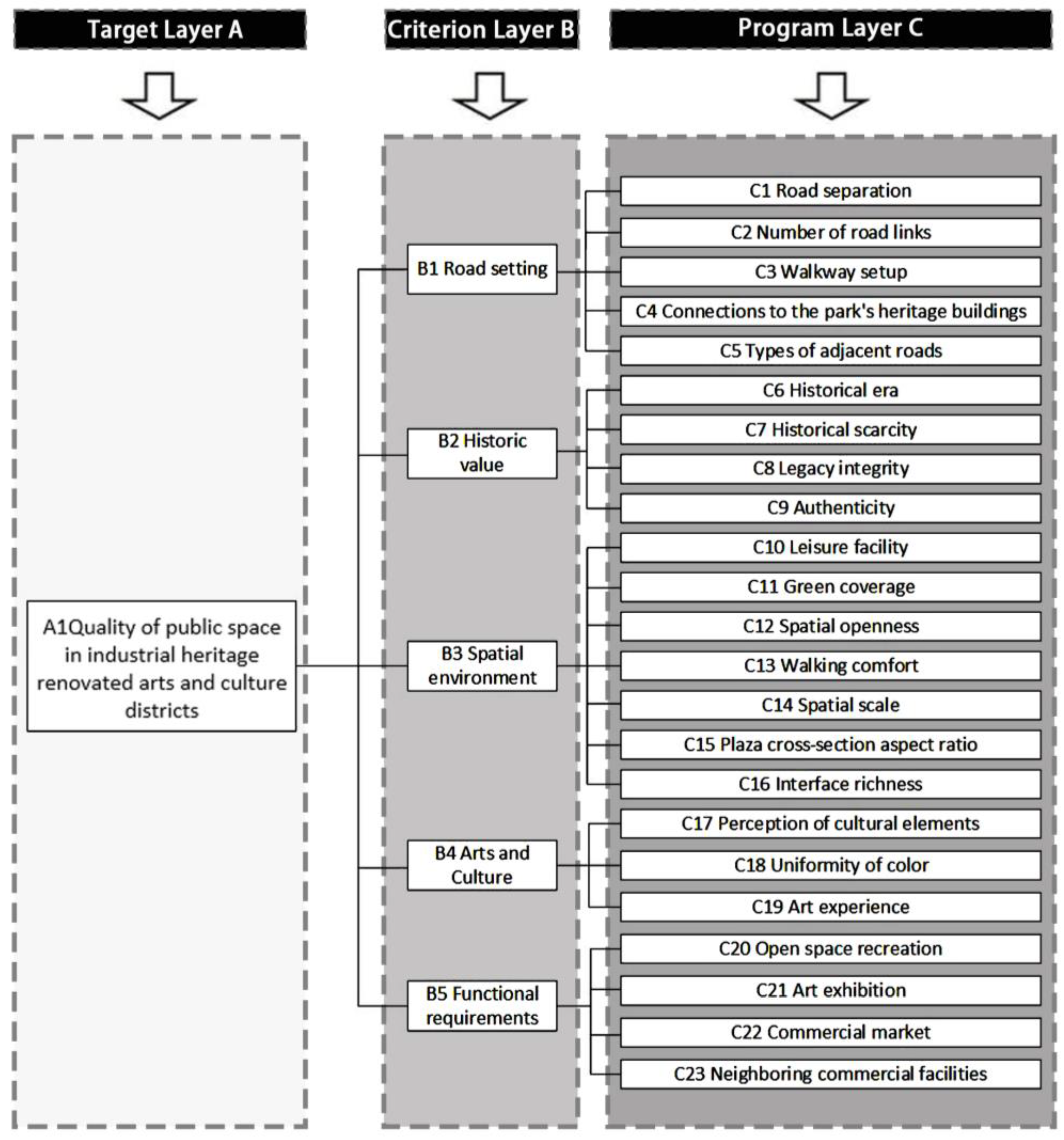
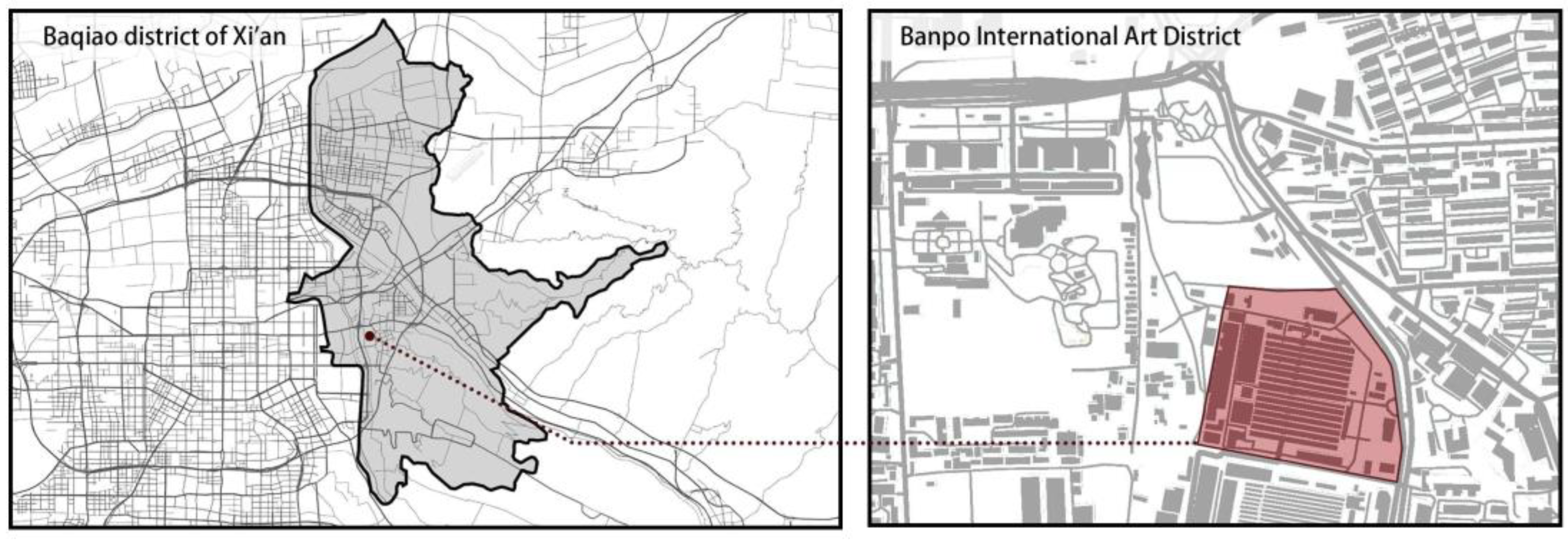

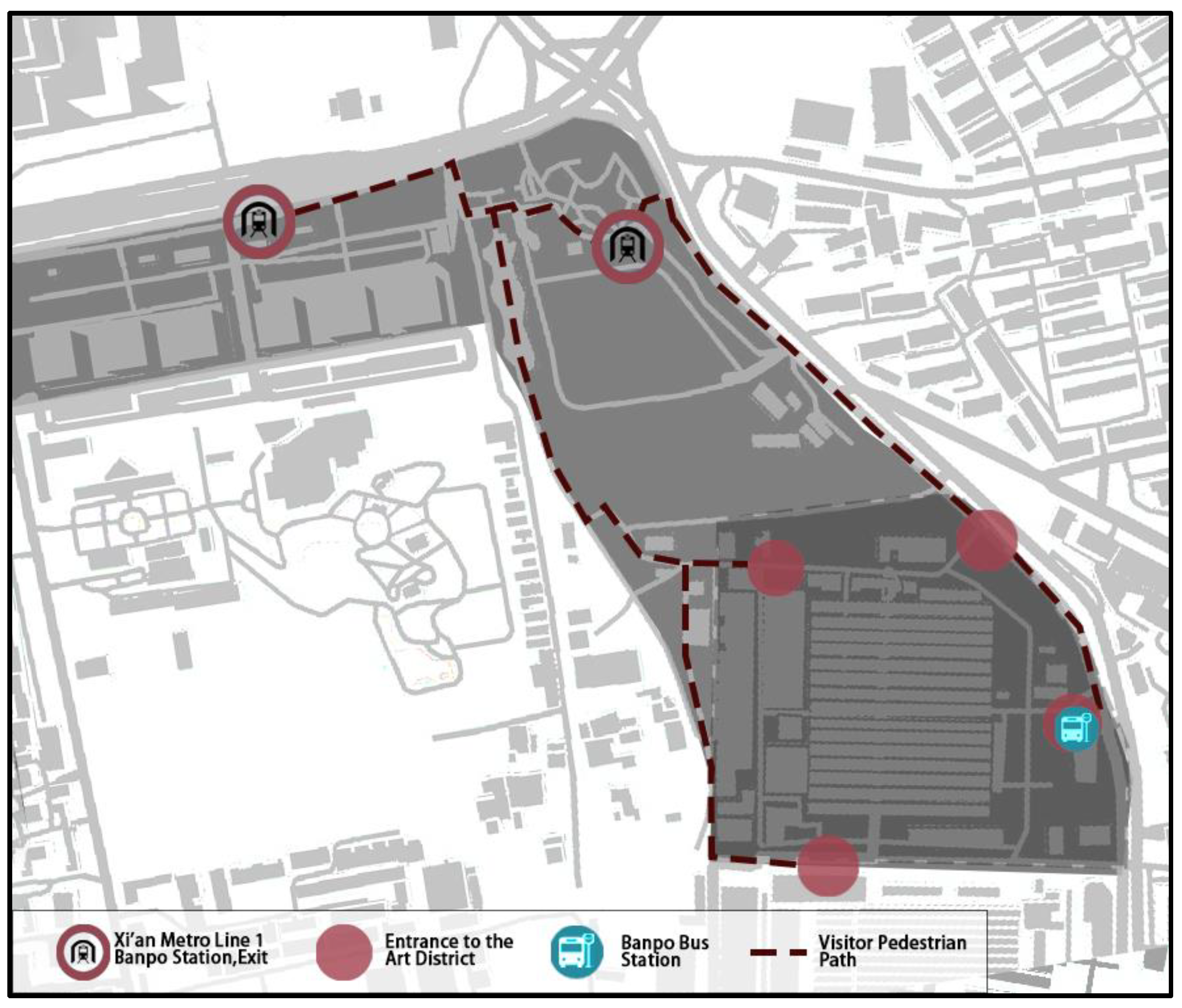
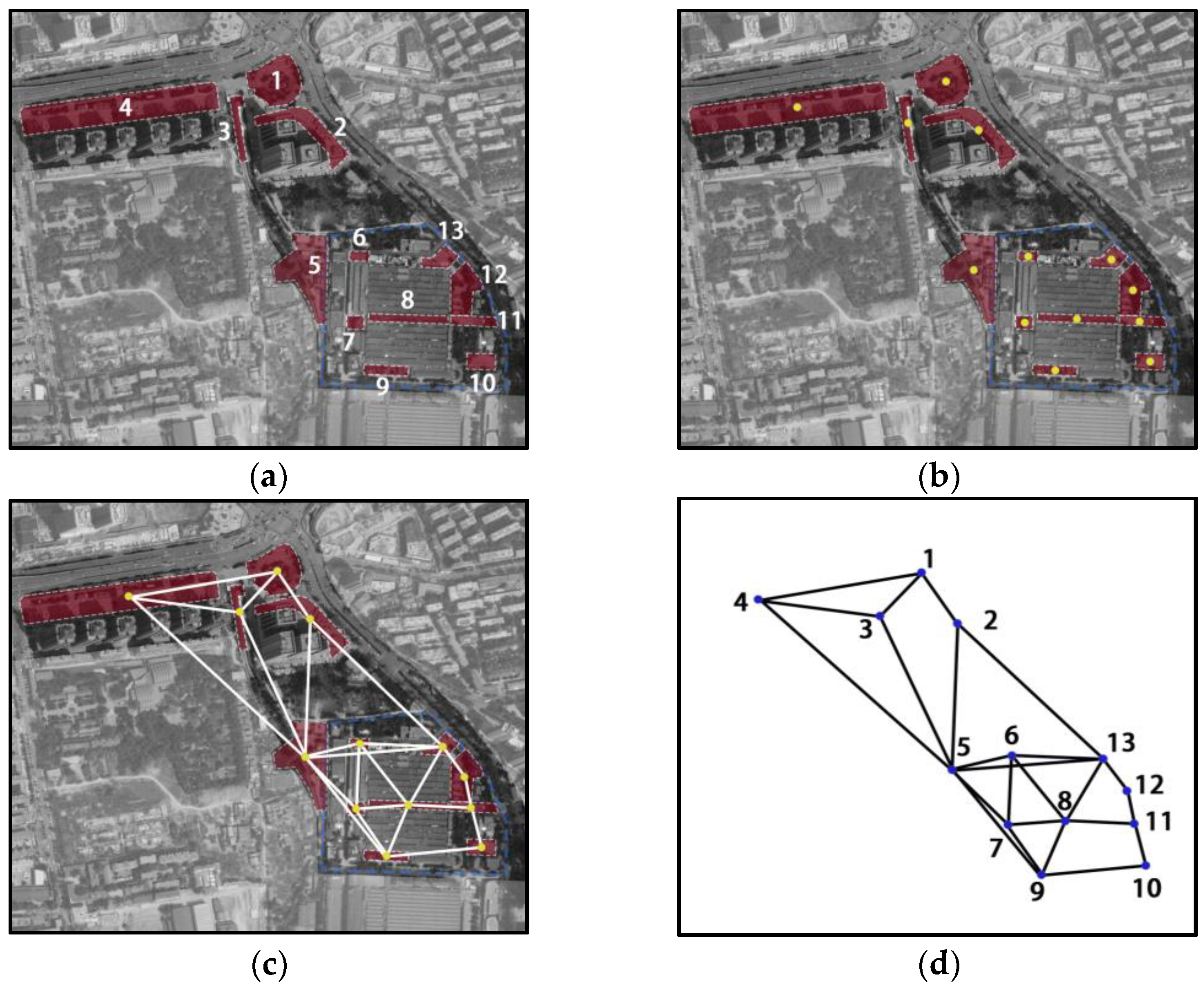
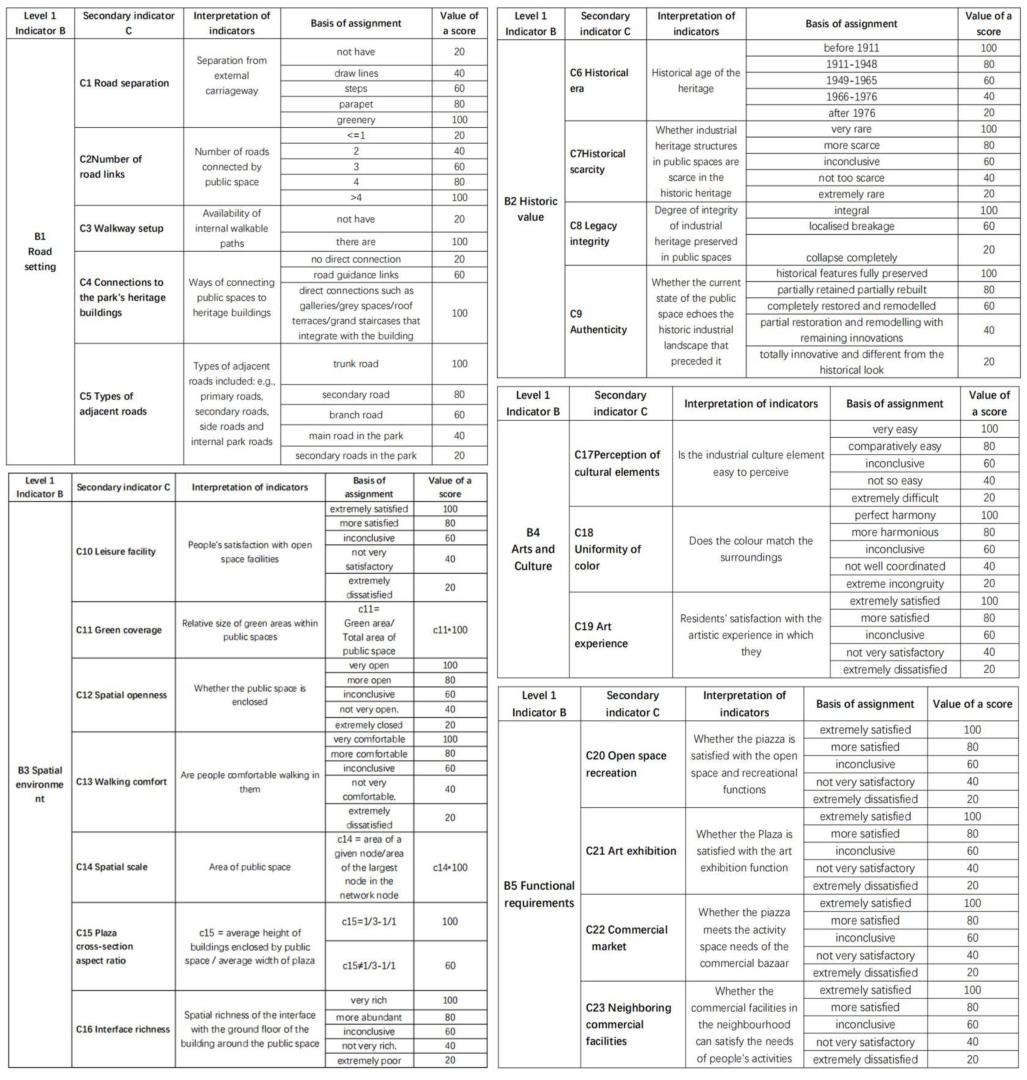

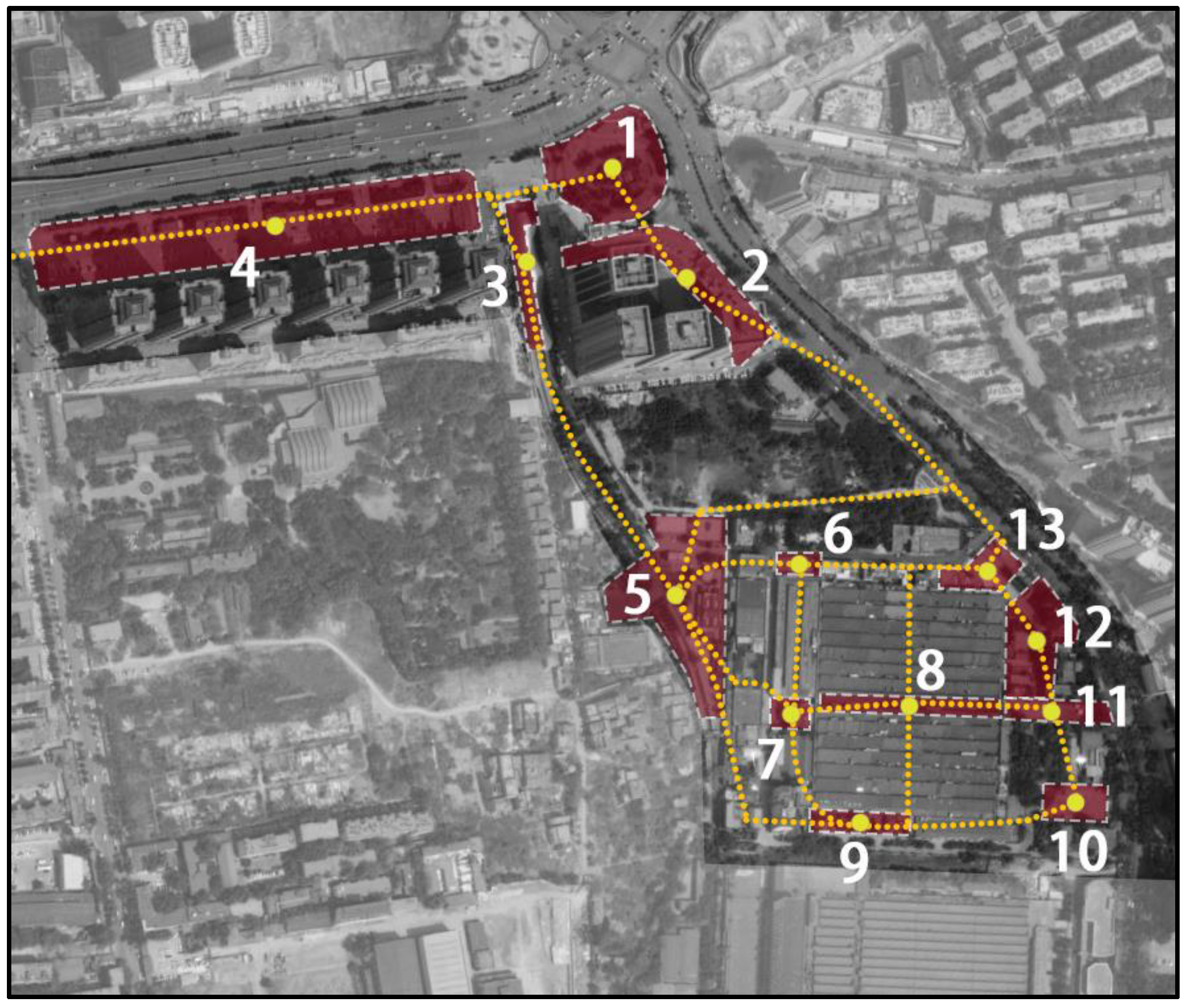

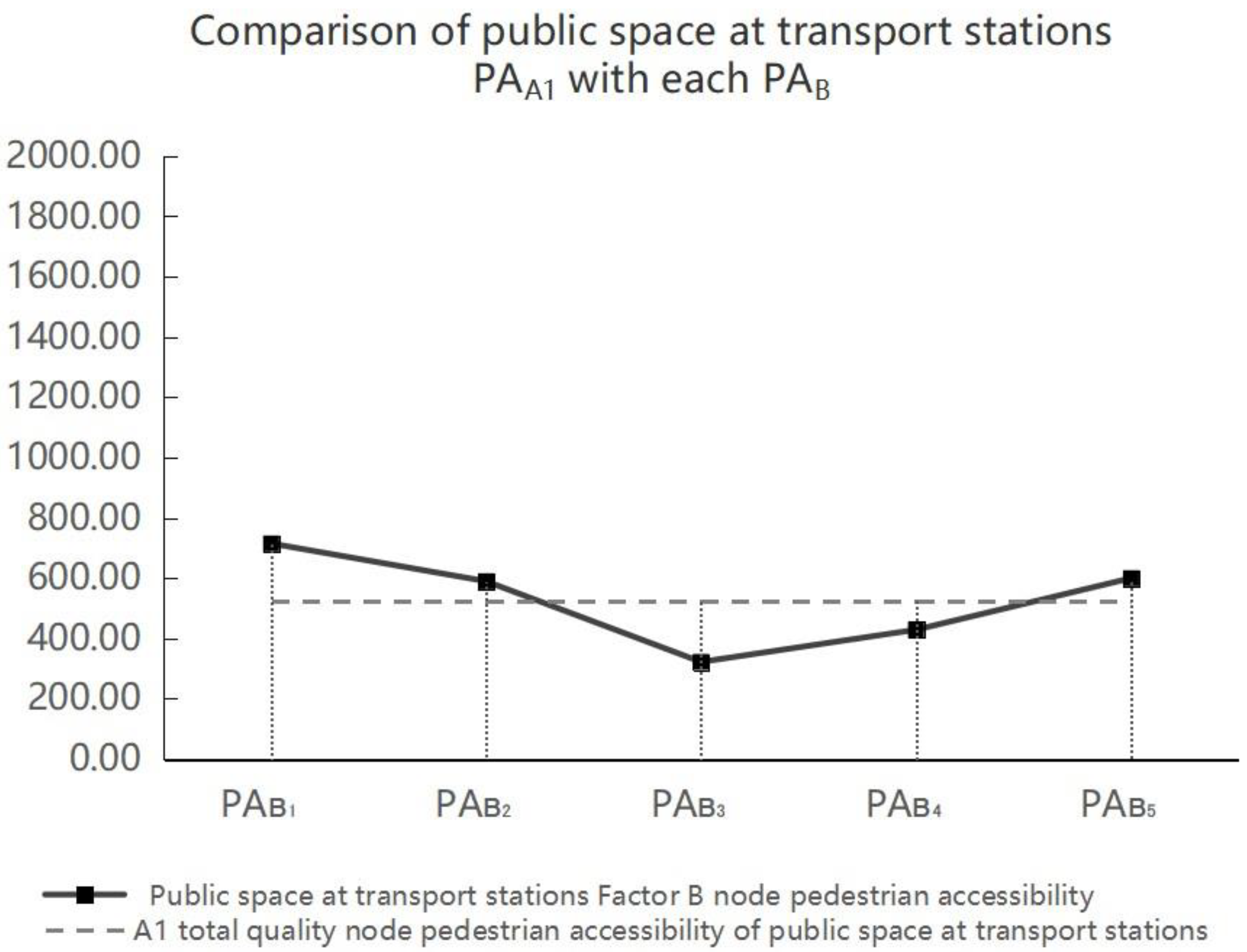
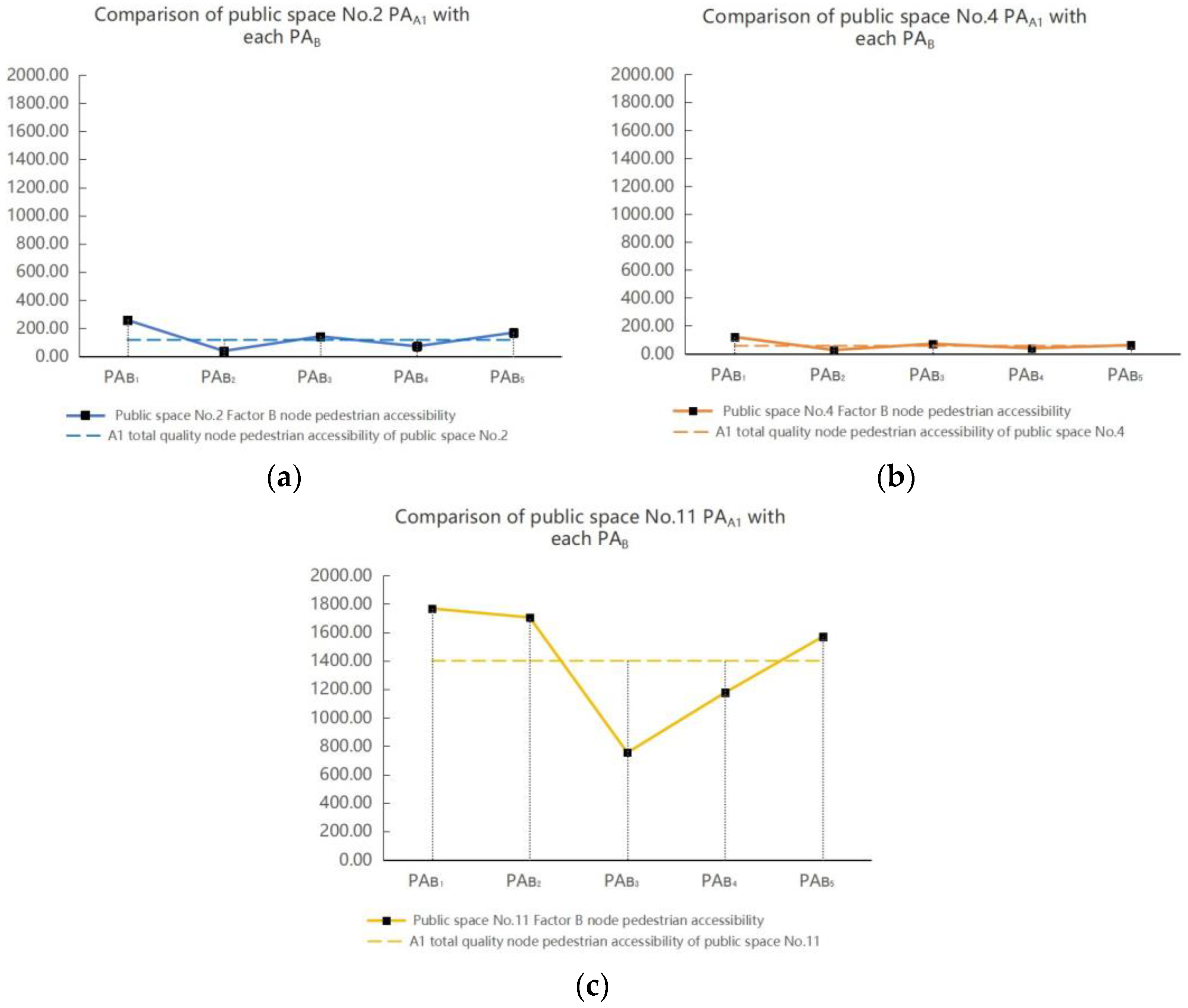
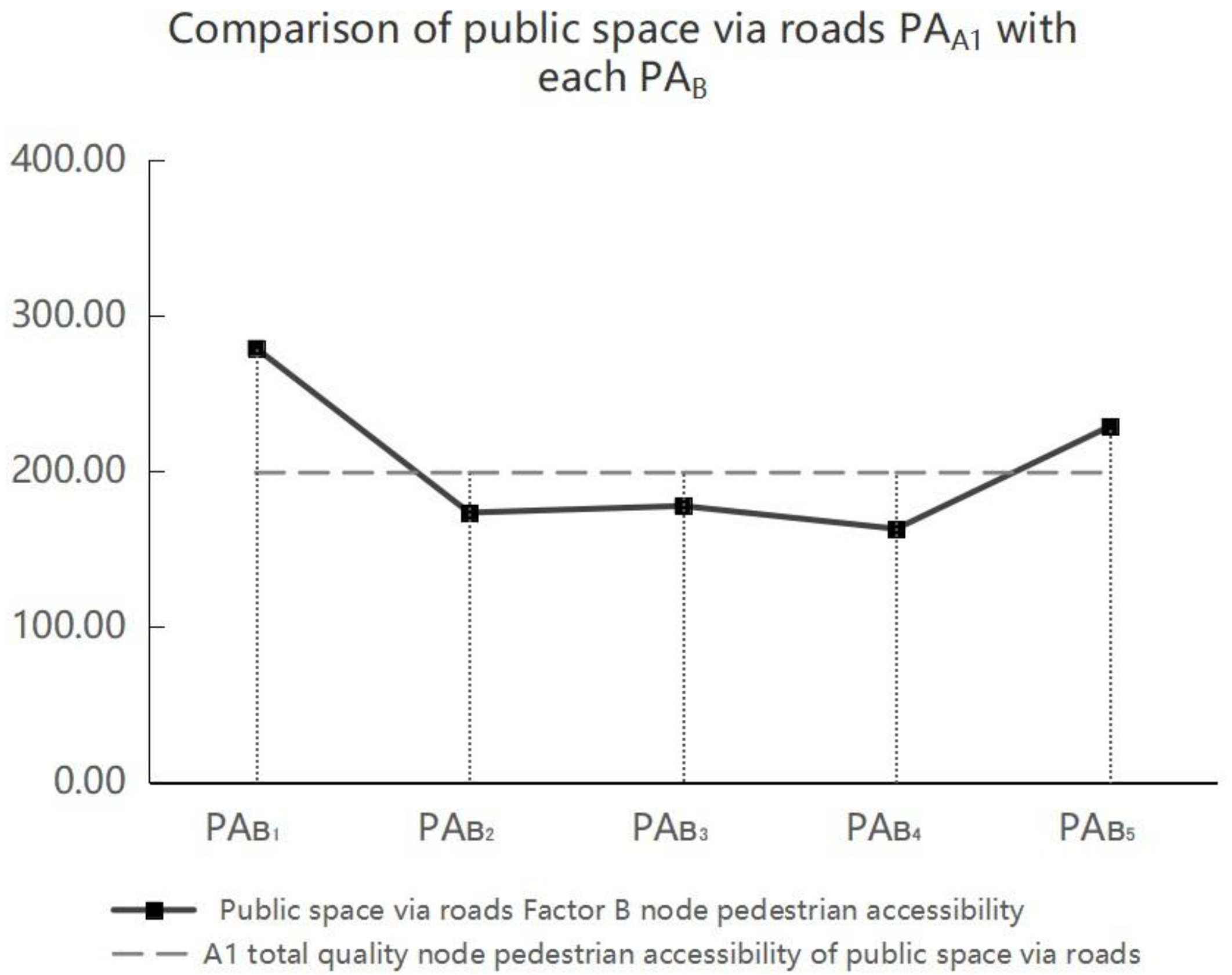
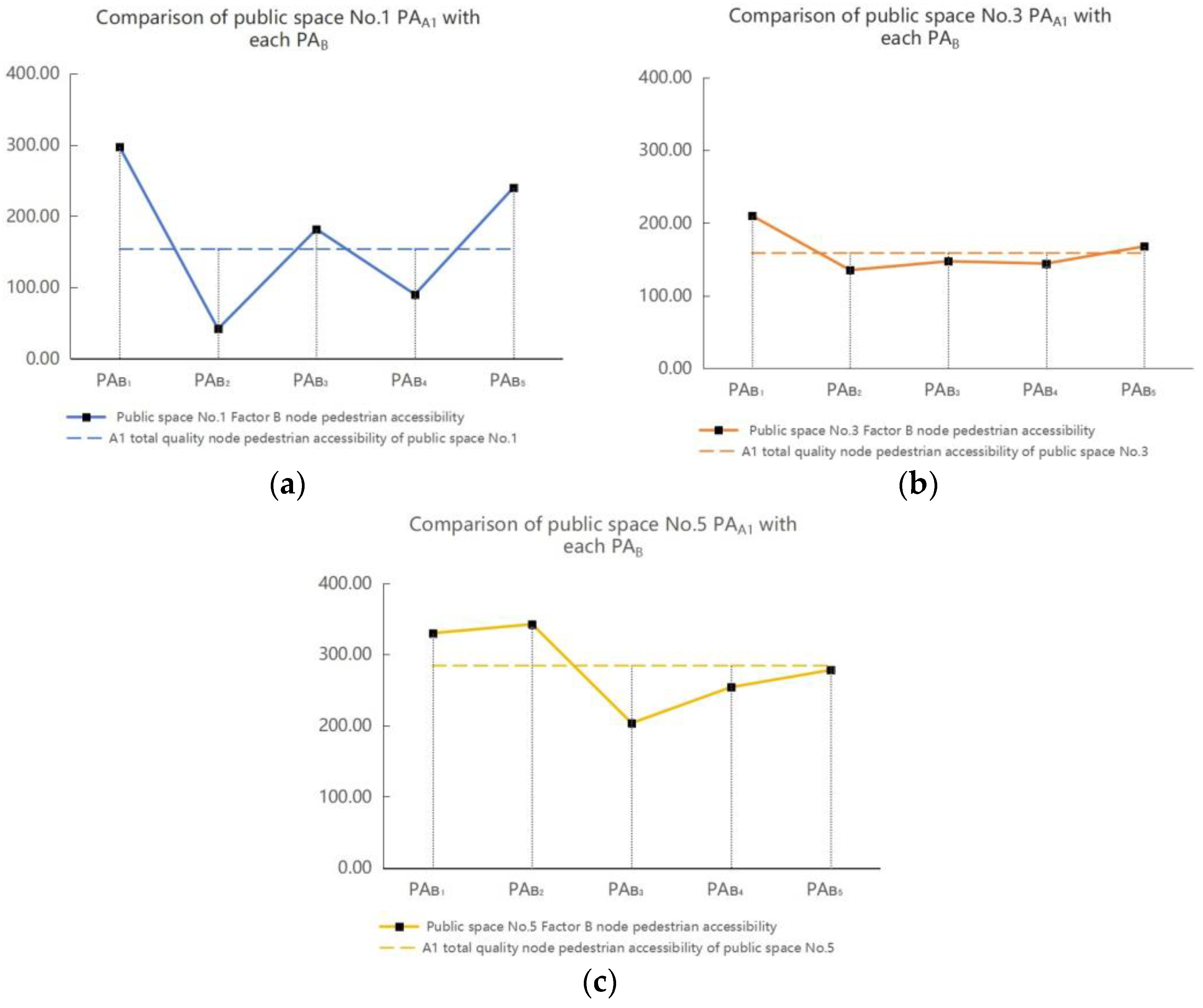

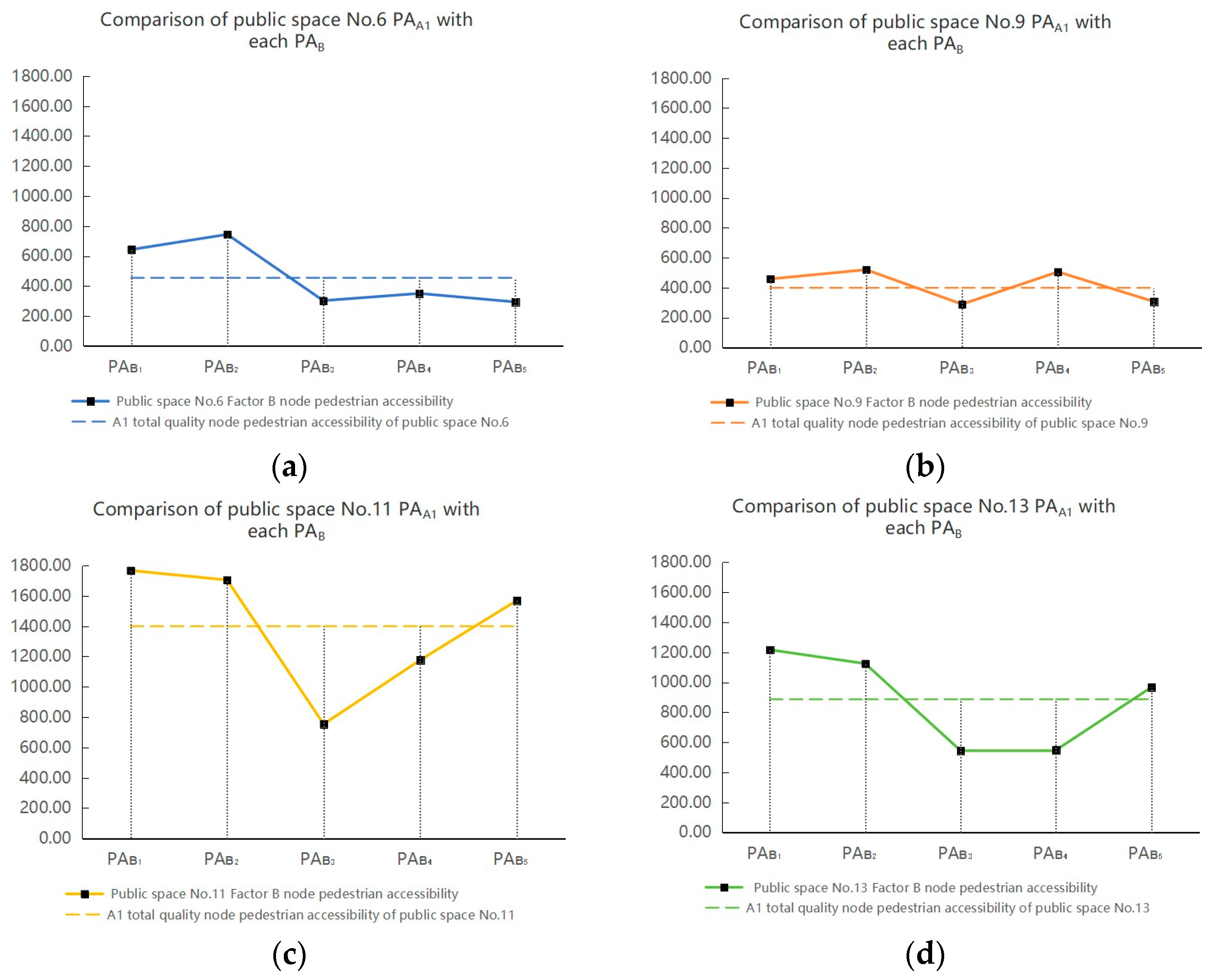
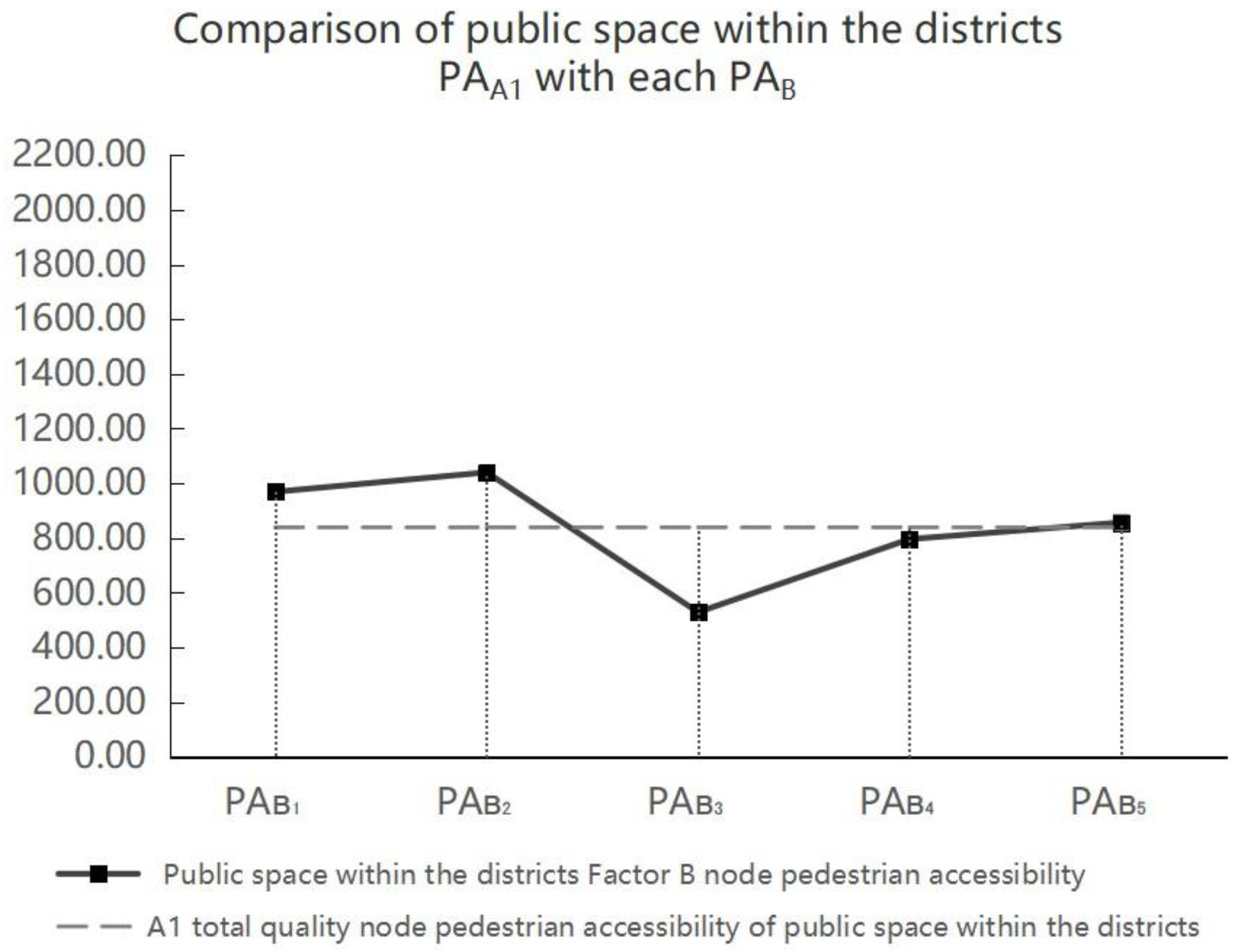

| Item Count | Sample Volume | Cronbach’s Alpha |
|---|---|---|
| 28 | 35 | 0.814 |
| Name | Average Value | Name | Average Value | Name | Average Value | Name | Average Value |
|---|---|---|---|---|---|---|---|
| B1 | 4.514 | C3 | 4.229 | C10 | 4.457 | C17 | 4.371 |
| B2 | 4.057 | C4 | 4.057 | C11 | 3.914 | C18 | 3.800 |
| B3 | 4.429 | C5 | 4.029 | C12 | 3.971 | C19 | 4.457 |
| B4 | 3.857 | C6 | 3.886 | C13 | 4.514 | C20 | 4.257 |
| B5 | 4.343 | C7 | 4.029 | C14 | 3.714 | C21 | 4.257 |
| C1 | 3.686 | C8 | 3.657 | C15 | 3.657 | C22 | 3.600 |
| C2 | 3.886 | C9 | 4.229 | C16 | 3.971 | C23 | 4.000 |
| Factor | AHP Method Weight w1 | Entropy Value Method Weight w2 | Average Weight w | Factor | AHP Method Weight w1 | Entropy Value Method Weight w2 | Average Weight w |
|---|---|---|---|---|---|---|---|
| B1 | 0.1402 | 0.0945 | 0.12 | C10 | 0.1451 | 0.1708 | 0.16 |
| B2 | 0.1564 | 0.3959 | 0.27 | C11 | 0.1303 | 0.1238 | 0.13 |
| B3 | 0.2531 | 0.1309 | 0.19 | C12 | 0.1303 | 0.1118 | 0.12 |
| B4 | 0.1437 | 0.1128 | 0.13 | C13 | 0.2715 | 0.0554 | 0.17 |
| B5 | 0.3066 | 0.2658 | 0.29 | C14 | 0.0903 | 0.1678 | 0.13 |
| C1 | 0.1236 | 0.1702 | 0.15 | C15 | 0.0796 | 0.2389 | 0.16 |
| C2 | 0.1899 | 0.1276 | 0.16 | C16 | 0.1338 | 0.1315 | 0.13 |
| C3 | 0.3088 | 0.2384 | 0.27 | C17 | 0.3392 | 0.2904 | 0.32 |
| C4 | 0.2396 | 0.0955 | 0.17 | C18 | 0.1505 | 0.2510 | 0.20 |
| C5 | 0.1381 | 0.3683 | 0.25 | C19 | 0.5103 | 0.4587 | 0.48 |
| C6 | 0.1177 | 0.3276 | 0.22 | C20 | 0.2690 | 0.1553 | 0.21 |
| C7 | 0.3226 | 0.2076 | 0.27 | C21 | 0.2610 | 0.1859 | 0.22 |
| C8 | 0.1965 | 0.3381 | 0.27 | C22 | 0.1329 | 0.3493 | 0.24 |
| C9 | 0.3632 | 0.1267 | 0.24 | C23 | 0.3371 | 0.3095 | 0.33 |
| Public Space | C 1 | C 2 | C 3 | C 4 | C 5 | C 6 | C 7 | C 8 | C 9 | C 10 | C 11 | C 12 | C 13 | C 14 | C 15 | C 16 | C 17 | C 18 | C 19 | C 20 | C 21 | C 22 | C 23 |
|---|---|---|---|---|---|---|---|---|---|---|---|---|---|---|---|---|---|---|---|---|---|---|---|
| No. 1 | 100 | 80 | 100 | 60 | 100 | 20 | 20.6 | 20 | 20 | 94.2 | 63.3 | 96.2 | 71.6 | 41.61 | 60 | 84.4 | 23.2 | 89.6 | 31.6 | 96 | 89 | 83.8 | 98 |
| No. 2 | 100 | 60 | 100 | 20 | 100 | 20 | 21.2 | 20 | 20 | 26.4 | 30.3 | 94.2 | 29 | 33.31 | 100 | 89.6 | 22 | 78.8 | 25.2 | 29 | 23.8 | 51 | 95.4 |
| No. 3 | 100 | 60 | 100 | 20 | 80 | 60 | 85.8 | 100 | 80 | 90.4 | 43.0 | 79.4 | 96.2 | 10.20 | 100 | 48.4 | 91 | 93 | 74.2 | 77.4 | 63.2 | 71.6 | 74.2 |
| No. 4 | 100 | 60 | 100 | 20 | 100 | 20 | 27 | 20 | 20 | 25.2 | 26.7 | 95.4 | 31.6 | 100 | 60 | 85.2 | 23.2 | 58.2 | 25.2 | 23.2 | 23.8 | 24.6 | 88.4 |
| No. 5 | 100 | 100 | 100 | 60 | 60 | 60 | 94.8 | 100 | 80 | 65.8 | 40.8 | 91.6 | 93.6 | 57.10 | 60 | 96.2 | 93.6 | 91.6 | 67.8 | 93 | 92.2 | 96.8 | 95.4 |
| No. 6 | 60 | 60 | 100 | 100 | 40 | 60 | 85.8 | 100 | 80 | 22.6 | 0.0 | 91 | 24.6 | 3.69 | 100 | 68.4 | 62.6 | 50.4 | 23.8 | 23.2 | 25.2 | 30.4 | 60 |
| No. 7 | 60 | 40 | 100 | 100 | 40 | 60 | 75.4 | 100 | 80 | 22.6 | 24.5 | 67.8 | 73.6 | 4.63 | 100 | 91 | 90.4 | 92.2 | 90.4 | 41.2 | 36.2 | 23.2 | 58 |
| No. 8 | 60 | 80 | 100 | 100 | 20 | 60 | 91.6 | 100 | 80 | 93 | 0.0 | 56.8 | 69.6 | 10.74 | 100 | 94.8 | 96.8 | 57.4 | 61.8 | 71.6 | 90.4 | 93.6 | 71.6 |
| No. 9 | 80 | 40 | 100 | 100 | 40 | 60 | 62.6 | 100 | 80 | 85.2 | 60.0 | 63.2 | 54.2 | 9.64 | 60 | 61.2 | 91 | 79.4 | 67.8 | 75.4 | 38.8 | 28.4 | 71 |
| No. 10 | 60 | 20 | 100 | 100 | 40 | 20 | 55.4 | 100 | 40 | 47 | 51.7 | 96.2 | 60 | 9.33 | 60 | 71 | 95.4 | 92.2 | 60 | 51.6 | 85.2 | 88.4 | 73.6 |
| No. 11 | 60 | 80 | 100 | 100 | 100 | 60 | 88.4 | 100 | 80 | 33 | 33.6 | 94.8 | 33.6 | 9.59 | 60 | 87 | 91.6 | 80.6 | 43.2 | 38.8 | 73.6 | 87.8 | 91.6 |
| No. 12 | 100 | 40 | 100 | 60 | 40 | 60 | 82.6 | 100 | 80 | 26.4 | 60.7 | 93 | 51.6 | 17.63 | 60 | 91 | 94.2 | 36.2 | 47.8 | 74.8 | 74.8 | 87.8 | 80.6 |
| No. 13 | 60 | 60 | 100 | 100 | 100 | 60 | 59.4 | 100 | 80 | 37.4 | 22.7 | 93.6 | 56.8 | 10.21 | 60 | 89.6 | 56.2 | 59.4 | 35.4 | 83.2 | 56.8 | 80.6 | 60 |
| Public Space | QA1 Total Quality Score of Public Space | QB1 Quality Score of Road Setting | QB2 Quality Score of Historic Value | QB3 Quality Score of Spatial Environment | QB4 Quality Score of Arts and Culture | QB5 Quality Score of Functional Requirements |
|---|---|---|---|---|---|---|
| No. 1 | 62.11 | 90.00 | 20.16 | 73.00 | 40.51 | 92.19 |
| No. 2 | 46.30 | 80.00 | 20.32 | 56.38 | 34.90 | 55.05 |
| No. 3 | 76.17 | 75.00 | 82.57 | 69.55 | 83.34 | 71.83 |
| No. 4 | 43.69 | 80.00 | 21.89 | 58.01 | 31.16 | 45.18 |
| No. 5 | 84.58 | 83.20 | 85.00 | 72.26 | 80.82 | 94.53 |
| No. 6 | 55.66 | 72.60 | 82.57 | 44.09 | 41.54 | 37.51 |
| No. 7 | 64.26 | 69.40 | 79.76 | 55.88 | 90.76 | 41.32 |
| No. 8 | 76.10 | 70.80 | 84.13 | 63.25 | 72.12 | 81.02 |
| No. 9 | 66.05 | 72.40 | 76.30 | 57.04 | 77.54 | 54.62 |
| No. 10 | 65.58 | 66.20 | 55.96 | 56.03 | 77.77 | 75.08 |
| No. 11 | 73.20 | 90.80 | 83.27 | 48.89 | 66.17 | 75.64 |
| No. 12 | 71.88 | 68.60 | 81.70 | 55.77 | 60.33 | 79.83 |
| No. 13 | 66.97 | 87.60 | 75.44 | 52.40 | 46.86 | 69.11 |
| Public Space | No. 1 | No. 2 | No. 3 | No. 4 | No. 5 | No. 6 | No. 7 | No. 8 | No. 9 | No. 10 | No. 11 | No. 12 | No. 13 |
|---|---|---|---|---|---|---|---|---|---|---|---|---|---|
| No. 1 | - | 2.125 | 3.125 | 5 | 8 | 7.75 | 9.25 | 8 | 11.25 | 8.75 | 7.875 | 7.125 | 6.125 |
| No. 2 | 2.125 | - | 5 | 6.5 | 8.375 | 6.75 | 8.5 | 8.125 | 10.25 | 7.625 | 6.875 | 6 | 5.125 |
| No. 3 | 3.125 | 5 | - | 3.375 | 4.875 | 5.375 | 6.625 | 7.875 | 8.625 | 9.875 | 9 | 8.25 | 7.25 |
| No. 4 | 5 | 6.5 | 3.375 | - | 8.375 | 9 | 10.25 | 11.5 | 12.25 | 13.75 | 12.5 | 11.75 | 10.75 |
| No. 5 | 8 | 8.375 | 4.875 | 8.375 | - | 2.125 | 3.375 | 4.5 | 5.25 | 6.625 | 5.75 | 5 | 4 |
| No. 6 | 7.75 | 6.75 | 5.375 | 9 | 2.125 | - | 1.625 | 2.375 | 3.5 | 4.5 | 3.875 | 3 | 2.125 |
| No. 7 | 9.25 | 8.5 | 6.625 | 10.25 | 3.375 | 1.625 | - | 1.625 | 1.75 | 3.875 | 3 | 3.625 | 4.625 |
| No. 8 | 8 | 8.125 | 7.875 | 11.5 | 4.5 | 2.375 | 1.625 | - | 1.75 | 3.875 | 3 | 3.625 | 4.625 |
| No. 9 | 11.25 | 10.25 | 8.625 | 12.25 | 5.25 | 3.5 | 1.75 | 1.75 | - | 2.875 | 4.75 | 4.625 | 5.5 |
| No. 10 | 8.75 | 7.625 | 9.875 | 13.75 | 6.625 | 4.5 | 3.875 | 3.875 | 2.875 | - | 1.125 | 1.625 | 2.625 |
| No. 11 | 7.875 | 6.875 | 9 | 12.5 | 5.75 | 3.875 | 3 | 3 | 4.75 | 1.125 | - | 0.75 | 1.75 |
| No. 12 | 7.125 | 6 | 8.25 | 11.75 | 5 | 3 | 3.625 | 3.625 | 4.625 | 1.625 | 0.75 | - | 0.875 |
| No. 13 | 6.125 | 5.125 | 7.25 | 10.75 | 4 | 2.125 | 4.625 | 4.625 | 5.5 | 2.625 | 1.75 | 0.875 | - |
| Public Space | PAA1 Total Quality Node Pedestrian Accessibility | PAB1 Road Setting Node Pedestrian Accessibility | PAB2 Historic Value Node Pedestrian Accessibility | PAB3 Spatial Environment Node Pedestrian Accessibility | PAB4 Arts and Culture Node Pedestrian Accessibility | PAB5 Functional Requirement Node Pedestrian Accessibility |
|---|---|---|---|---|---|---|
| No. 1 | 153.98 | 297.07 | 42.13 | 181.88 | 90.42 | 240.08 |
| No. 2 | 116.35 | 257.51 | 37.73 | 141.59 | 70.94 | 167.85 |
| No. 3 | 158.81 | 210.15 | 135.35 | 147.47 | 144.34 | 167.95 |
| No. 4 | 57.17 | 120.17 | 26.90 | 71.51 | 39.03 | 62.25 |
| No. 5 | 284.40 | 330.10 | 342.68 | 203.66 | 254.17 | 278.23 |
| No. 6 | 455.05 | 643.38 | 744.34 | 302.87 | 351.09 | 294.18 |
| No. 7 | 554.29 | 657.53 | 803.15 | 396.96 | 740.62 | 336.20 |
| No. 8 | 534.47 | 561.37 | 692.66 | 372.04 | 559.53 | 481.30 |
| No. 9 | 398.74 | 457.78 | 519.62 | 289.19 | 505.30 | 306.83 |
| No. 10 | 652.58 | 759.95 | 631.49 | 415.35 | 701.23 | 762.78 |
| No. 11 | 1399.70 | 1767.46 | 1704.74 | 753.78 | 1176.55 | 1569.58 |
| No. 12 | 1615.63 | 1898.12 | 2033.70 | 932.02 | 1183.36 | 1847.47 |
| No. 13 | 886.83 | 1216.51 | 1124.53 | 544.04 | 548.20 | 967.04 |
| Node Category | PAA1 Total Quality Node Pedestrian Accessibility | PAB1 Road Setting Node Pedestrian Accessibility | PAB2 Historic Value Node Pedestrian Accessibility | PAB3 Spatial Environment Node Pedestrian Accessibility | PAB4 Arts and Culture Node Pedestrian Accessibility | PAB5 Functional Requirement Node Pedestrian Accessibility |
|---|---|---|---|---|---|---|
| Public space at transport stations | 524.41 ± 758.60 | 715.05 ± 914.00 | 589.79 ± 965.59 | 322.29 ± 375.32 | 428.84 ± 647.73 | 599.89 ± 841.43 |
| Public space via roads | 199.06 ± 73.94 | 279.11 ± 61.96 | 173.39 ± 153.84 | 177.67 ± 28.33 | 162.98 ± 83.45 | 228.75 ± 56.01 |
| Public space at the entrance of the district | 785.08 ± 464.14 | 1021.28 ± 593.08 | 1023.31 ± 518.37 | 472.47 ± 221.07 | 645.29 ± 364.15 | 784.41 ± 610.53 |
| Public space within the district | 839.24 ± 520.16 | 969.24 ± 624.54 | 1040.25 ± 666.10 | 529.09 ± 269.20 | 796.19 ± 269.58 | 856.94 ± 683.69 |
| Variable Pair | Correlation Coefficient (r) | Significance | Strength of Relationship | Strength of Evidence |
|---|---|---|---|---|
| QA1-PAA1 | 0.377 | p = 0.205 | Weak Correlation | Not Significant |
| QB1-PAB1 | 0.585 | p = 0.036 | Moderate Correlation | Significant |
| QB2-PAB2 | 0.931 | p < 0.001 | Very Strong Correlation | Highly Significant |
| QB3-PAB3 | 0.654 | p = 0.015 | Moderately Strong Correlation | Significant |
| QB4-PAB4 | 0.834 | p < 0.001 | Strong Correlation | Highly Significant |
| QB5-PAB5 | 0.793 | p = 0.001 | Strong Correlation | Highly Significant |
| Node | Aspects to Be Improved | Strategies |
|---|---|---|
| No. 2 | PAB2 Historic value node pedestrian accessibility PAB4 Arts and culture node pedestrian accessibility |
|
| No. 4 | PAB2 Historic value node pedestrian accessibility PAB4 Arts and culture node pedestrian accessibility |
|
| No. 11 | PAB3 Spatial environment node pedestrian accessibility PAB4 Arts and culture node pedestrian accessibility |
|
| Node | Aspects to Be Improved | Strategies |
|---|---|---|
| No. 3 | PAB2 Historic value node pedestrian accessibility PAB3 Spatial environment node pedestrian accessibility PAB4 Arts and culture node pedestrian accessibility |
|
| No. 5 | PAB3 Spatial environment node pedestrian accessibility PAB4 Arts and culture node pedestrian accessibility |
|
| Node | Aspects to Be Improved | Strategies |
|---|---|---|
| No. 9 | PAB3 Spatial environment node pedestrian accessibility PAB5 Functional requirement node pedestrian accessibility |
|
| No. 11 | PAB3 Spatial environment node pedestrian accessibility PAB4 Arts and culture node pedestrian accessibility |
|
| No. 13 | PAB3 Spatial environment node pedestrian accessibility PAB4 Arts and culture node pedestrian accessibility |
|
| Node | Aspects to Be Improved | Strategies |
|---|---|---|
| No. 8 | PAB3 Spatial environment node pedestrian accessibility PAB5 Functional requirement node pedestrian accessibility |
|
| No. 10 | PAB3 Spatial environment node pedestrian accessibility |
|
| No. 12 | PAB3 Spatial environment node pedestrian accessibility PAB4 Arts and culture node pedestrian accessibility |
|
| Order | 1 | 2 | 3 | 4 | 5 | 6 | 7 | 8 | 9 | 10 | 11 | 12 | 13 |
|---|---|---|---|---|---|---|---|---|---|---|---|---|---|
| Public space | No. 12 | No. 11 | No. 13 | No. 7 | No. 6 | No. 10 | No. 8 | No. 9 | No. 5 | No. 1 | No. 3 | No. 2 | No. 4 |
| Ik | 0.005110609 | 0.004756637 | 0.004186894 | 0.003808573 | 0.003803423 | 0.003689347 | 0.003516231 | 0.00308277 | 0.002628514 | 0.002199483 | 0.00215923 | 0.002154855 | 0.001539233 |
| Order | 1 | 2 | 3 | 4 | 5 | 6 | 7 | 8 | 9 | 10 | 11 | 12 | 13 |
|---|---|---|---|---|---|---|---|---|---|---|---|---|---|
| Public space | No. 12 | No. 11 | No. 13 | No. 10 | No. 7 | No. 8 | No. 6 | No. 9 | No. 5 | No. 3 | No. 1 | No. 2 | No. 4 |
| PAA1 | 1615.63 | 1399.7 | 886.83 | 652.58 | 554.29 | 534.47 | 455.05 | 398.74 | 284.4 | 158.81 | 153.98 | 116.35 | 57.17 |
| ρB1 | ρB2 | ρB3 | ρB4 | ρB5 |
|---|---|---|---|---|
| 0.967213115 | 0.754098361 | 0.983606557 | 0.961748634 | 0.87431694 |
Disclaimer/Publisher’s Note: The statements, opinions and data contained in all publications are solely those of the individual author(s) and contributor(s) and not of MDPI and/or the editor(s). MDPI and/or the editor(s) disclaim responsibility for any injury to people or property resulting from any ideas, methods, instructions or products referred to in the content. |
© 2025 by the authors. Licensee MDPI, Basel, Switzerland. This article is an open access article distributed under the terms and conditions of the Creative Commons Attribution (CC BY) license (https://creativecommons.org/licenses/by/4.0/).
Share and Cite
Xu, X.; Ding, E.; Yu, K.; Yu, J.; Liu, W.; Bo, L. Modeling Pedestrian Accessibility: Research on Public Space of Industrial Heritage Renovated Districts. Buildings 2025, 15, 4142. https://doi.org/10.3390/buildings15224142
Xu X, Ding E, Yu K, Yu J, Liu W, Bo L. Modeling Pedestrian Accessibility: Research on Public Space of Industrial Heritage Renovated Districts. Buildings. 2025; 15(22):4142. https://doi.org/10.3390/buildings15224142
Chicago/Turabian StyleXu, Xin, Enxuan Ding, Kanhua Yu, Jinting Yu, Wei Liu, and Liming Bo. 2025. "Modeling Pedestrian Accessibility: Research on Public Space of Industrial Heritage Renovated Districts" Buildings 15, no. 22: 4142. https://doi.org/10.3390/buildings15224142
APA StyleXu, X., Ding, E., Yu, K., Yu, J., Liu, W., & Bo, L. (2025). Modeling Pedestrian Accessibility: Research on Public Space of Industrial Heritage Renovated Districts. Buildings, 15(22), 4142. https://doi.org/10.3390/buildings15224142






